#Hashemite Kingdom of Jordan
Text
TO ANY JORDANIANS ON TUMBLR:

There’s going to be a fundraising event for Gaza tomorrow (November 3rd) at Swefieh Village! 12-7 pm! 40+ vendors! Food! If you can come, help support our brothers and sister in Gaza.
#free palestine#palestine#gaza#jordan#arab stuff#Hashemite kingdom of Jordan#Arabs#gaza strip#Idk at what time I’m going but I AM going#You can check Swefieh Village’s Instagram for mor info!#free gaza#gaza under attack#save gaza#jordanians#trying to tag this with whatever and everything so it can be seen more#ceasefire#ceasefire now#kingdom of jordan#swefieh village
23 notes
·
View notes
Text

"I do enjoy a good royal wedding" (semicit.)
One of the portraits released on the occasion of the wedding of Crown Prince Hussein and Princess Rajwa of Jordan.
#crown prince hussein#cp hussein#jordanian royal wedding#jordanian royal family#rajwa al saif#queen rania#king abdullah ii#hashemite kingdom of jordan#elie saab#princess rajwa
24 notes
·
View notes
Text
HELL FUCKING YEA

#First time reaching semi-finals let's goooooo#Legendary match#asian cup 2023#Jordan#Hashemite kingdom of Jordan#We are awesome#كأس آسيا#الاردن
1 note
·
View note
Text
Jordan Independence Day Amman
Jordanian Flag Independence Day – Edarabia
May 25 is Jordan Independence Day, and the “most important event in the history of the country, marking its independence from the British government in 1946”. The 2023 celebration signifies 75 years since Jordan “officially gained full autonomy in 1948“.
King Abdullah I bin Al-Hussein
“Jordan’s independence took place during the reign of King Abdullah I…

View On WordPress
#Al Shareef Hussein Bin Ali – Emir of Mecca - King of the Hijaz - King of the Arabs#Arab League#Arab Revolt Against the Ottoman Empire#Autonomous Constitutional Monarchy#Council of the League of Nations#Emirate of Transjordan#Great Arab Revolt#Hashemite Army of the Great Arab Revolt#Hashemite Kingdom of Jordan#Hashemites#His Majesty King Abdullah I Emir of Transjordan 1921-1946#His Majesty King Abdullah II – King of the Hashemite Kingdom of Jordan 1999 to Present#His Majesty King Al Hussein – King of the Hashemite Kingdom of Jordan 1952-1999#His Majesty King Talal – King of the Hashemite Kingdom of Jordan 1951-1952#House of Hashem#Jordan 1946 Independence from the British Government#Jordan Houses – Senate - House of Representatives#Jordan Independence Day May 25#Jordan WWI Allies Britain and France#Jordanian Armed Forces#Khamaseen Winds#King Abdullah I bin Al-Hussein#King of the Hashemite Kingdom of Jordan 1946-1951#Ottoman Empire#Presentation of Colours Ceremony#Sharif Hussein of Mecca#The Emir#Transjordan#Transjordan Memorandum#United Nations
1 note
·
View note
Text
From Adam Mestyan, author of the new book, Modern Arab Kingship: Remaking the Ottoman Political Order in the Interwar Middle East (BOOK | KINDLE), which probably doesn't sound all that exciting to most of you but I go for the deep tracks when it comes to the history of Arab monarchies. It's fascinating, I promise you.
#History#Books#Middle East#Arab History#Arab Monarchs#Hashemite Kingdom#Hashemite Dynasty#Sharif Hussein#Ottoman Empire#Fall of the Ottoman Empire#Saudi Arabia#Jordan#Saudi Arabian History#Jordanian History#Iraqi History
16 notes
·
View notes
Text
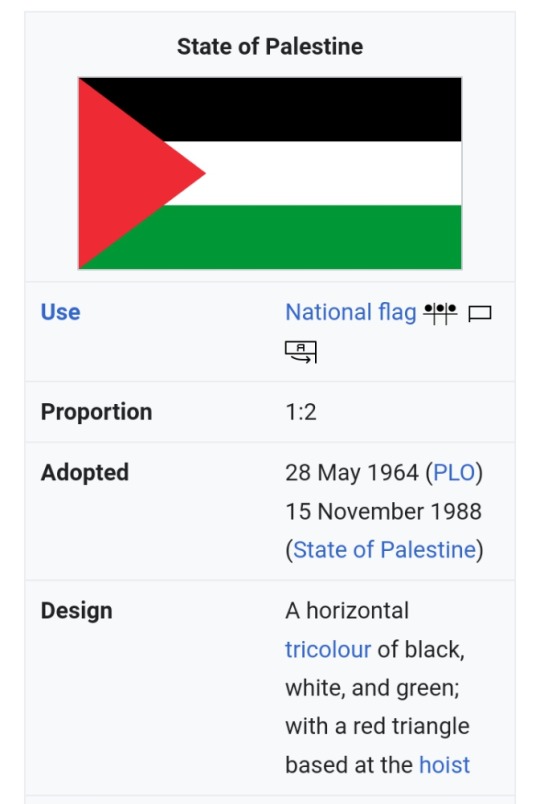



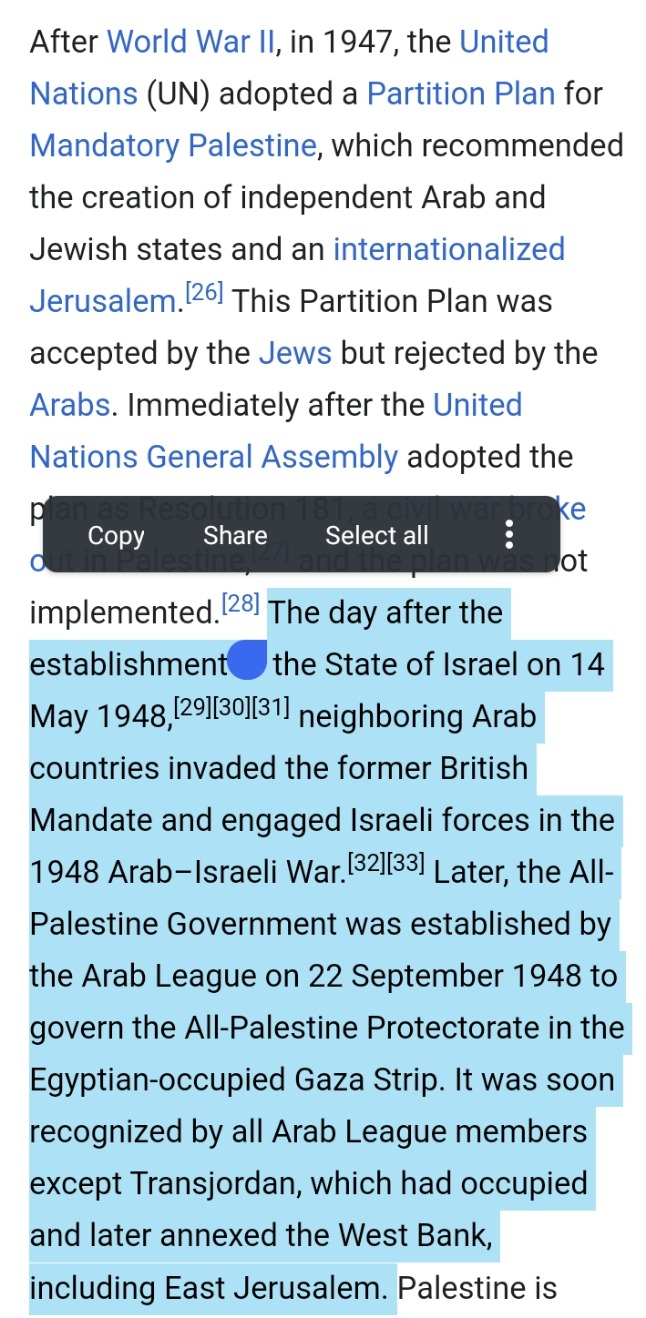
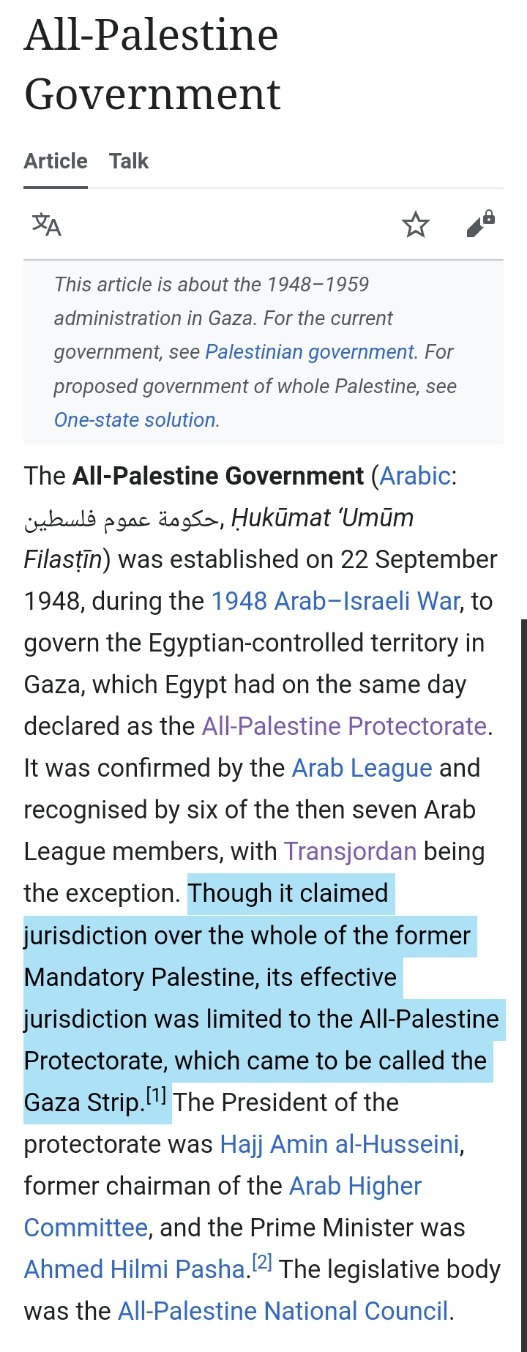

These are all quite interesting, I've more research to do related to this but thought I'd share it with y'all.
#christian blog#palestine#state of palestine#jordan#egypt#arab league#all palestine government#the arab league#the hashemite kingdom of jordan#mandatory palestine#israel
1 note
·
View note
Text

Emmet Gowin, from the series Petra in the Hashemite Kingdom of Jordan (1986)
via the disappeared visionsdeimsomnio
970 notes
·
View notes
Photo


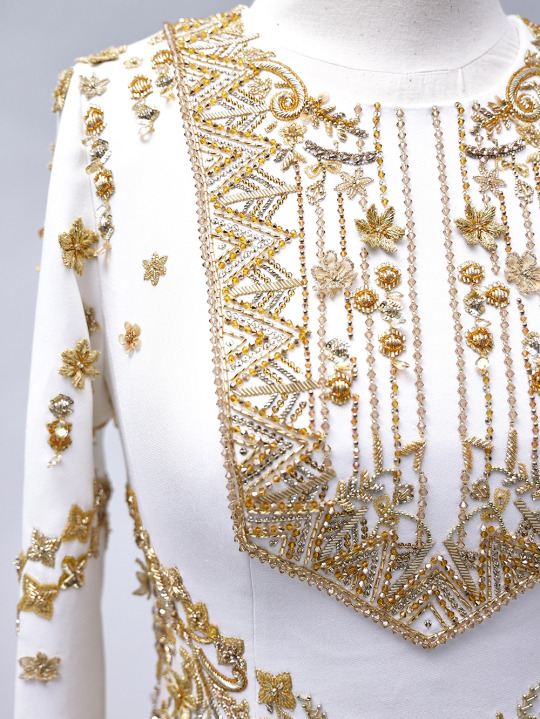
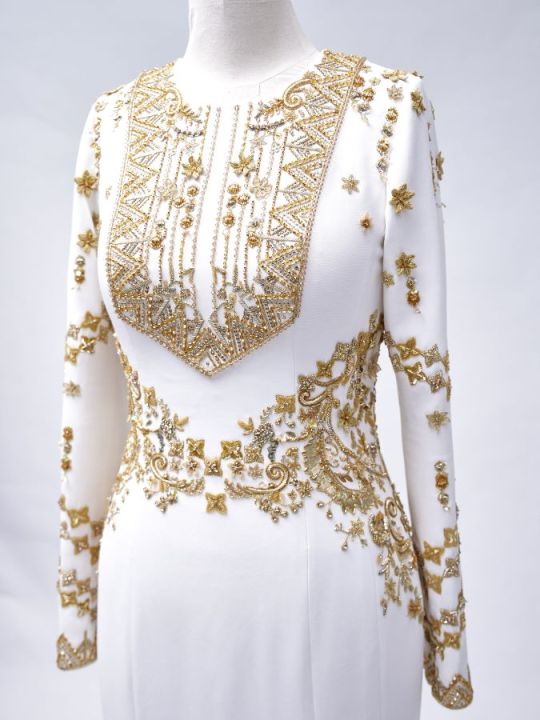






Close-up of Rajwa Al Saif's henna party outfit on 22 May 2023. The dress, by Saudi designer Honayda Serafi, took more than 2,000 hours to create, and includes several hidden messages of love, Vogue Arabia reports.
“Crafted by Saudi designer Honayda Serafi, Al-Saif’s henna dress is a vision in white and gold. The future queen of Jordan celebrated with family and friends in a look that takes inspiration from the traditional Najdi dress, known as Sahabi thoub, which originates from the Najd region of the Kingdom of Saudi Arabia. Keeping in mind the occasion and the family, Serafi made sure to combine the cultural beauty of the Hashemite kingdom of Jordan and the Kingdom of Saudi Arabia to celebrate the union of Rajwa and Prince Hussein beautifully.
Featuring a handcrafted veil and dress, Rajwa Al-Saif’s pristine white henna outfit comes doused in 3D ornaments, made using a mix of silk, metallic threads and traditional reed strings (a signature element of Najdi embroidery). To create this masterpiece, Honayda Serafi took cues from the bride’s personality, attempting to reflect her innate grace, the rich traditions of her land, and her contemporary spirit.
Look closely, and you’ll notice that Al-Saif’s gown is replete with lovingly made details. Featuring a high round neck and full sleeves, the crepe gown features an inverted triangle-shaped bodice that is inspired by the traditional Najdi bodice design, normally worn as a separate piece. As the body-skimming gown continues, it flares out towards the ankles to create a mermaid-esque shape. The bodice of the gown is elevated using embroidery: soft organza flowers share space with geometric shapes and Arabic motifs, all of which are typical to Saudi Arabia and reflect the beauty and traditions of the bride’s homeland.
Rajwa Al-Saif’s veil has also been embroidered with meaningful designs, making this piece so personal to her journey. Seven Jordanian stars adorn her veil to signify the seven-pointed star that sits proudly on the Jordanian flag. What makes this symbol even more special is its religious meaning: The star on the Jordan flag signifies the seven verses in the opening chapter of the Holy Qur’an, and the seven mountains of Amman.
Along with the stars, the veil also features intricate palm trees as a reference to Saudi Arabia, and even some poetry. The words “I see you, and life becomes more beautiful” have been embroidered into Al-Saif’s veil, from Tunisian poet Abu al-Qasim al-Shabi, known for his Andalusian notes. If you’re a fan of Rajwa Al-Saif’s elegant wardrobe, you may already know that the bride-to-be has a soft spot for special symbols when it comes to her clothing. Back in August 2022, when Rajwa was officially engaged to Prince Hussein, she also commemorated the occasion with her clothing—an abaya that was embroidered with two gold birds, symbolizing two souls in love.”
The veil took 760 hours to complete
An exquisite piece of couture requires hours of effort, and Rajwa Al-Saif’s henna outfit is no different. According to the designer, Al-Saif’s veil took 760 hours to complete, and was worked on by a team of experts, craftsman and women. Extending to 10 meters, the piece was made using handcrafted tulle, a process that normally takes close to 2,000 hours of work. As for her billowing gown, the creation is the result of 340 hours of work.
Honayda Serafi: “I am very proud and honored to be part of this historic union”
Speaking on the occasion, Serafi shared, “I am very proud and honored to be part of this historic union between His Royal Highness, Crown Prince Al Hussein bin Abdullah II of the honorable Hashemite family, and Miss Rajwa Khalid Alseif. May they be blessed with happiness and their union be crowned with success.” (x)
804 notes
·
View notes
Text
"My father was born in 1905 in Bethlehem as an Ottoman citizen with Ottoman identification papers. As a teenager he witnessed the Ottomans being replaced by the British, and suddenly, almost overnight, he became a citizen of Mandate Palestine with a Palestinian passport issued by the British Mandate government. In 1949, when Bethlehem became part of Jordan, he became suddenly a citizen of the Hashemite Kingdom of Jordan. And when he died in 1975, he died under Israeli occupation with an ID card issued by Israel. But he was the same person throughout those geo-political vicissitudes and had no choice but to adjust to changing political and imperial realities.
Throughout Palestinian history empires have occupied the land for a certain number of years but were then forced to leave. Most of the time an empire departed only to make space for another empire. The majority of the native people of the land seldom left. Throughout history and starting with the Assyrian Exile, only a small minority was deported, and only a small percentage decided to leave. The vast majority of the native people remained in the land of their forefathers (2 Kgs 25:11). They remained the Am Haaretz, the native 'People of the Land,' in spite of the diverse empires controlling that land. This is why in this book I choose the people of the land as the description for the native inhabitants throughout history, for it is they who are the enduring continuum.
Their identity, however, was forced to change and develop according to the new realities and empires in which they found themselves. They changed their language from Aramaic to Greek to Arabic, while their identity shifted from Canaanite, to Hittite, to Hivite, to Perizzite, to Girgashite, to Amorite, to Jebusite, to Philistine, Israelite, Judaic/Samaritan, to Hasmonaic, to Jewish, to Byzantine, to Arab, to Ottoman, and to Palestinian, to mention some. The name of the country also changed from Canaan to Philistia, to Israel, to Samaria and Juda, to Palestine. ... And yet they stayed, throughout the centuries, and remained the people of the land with a dynamic identity. In this sense Palestinians today stand in historic continuity with biblical Israel. The native people of the land are the Palestinians. The Palestinian people (Muslims, Christians, and Palestinian Jews) are a critical and dynamic continuum from Canaan to biblical times, from Greek, Roman, Arab, and Turkish eras up to the present day. They are the native peoples, who survived those empires and occupations, and they are also the remnant of those invading armies and settlers who decided to remain in the land to integrate rather than to return to their original homelands. The Palestinians are the accumulated outcome of this incredible dynamic history and these massive geo-political developments."
Mitri Raheb, Faith in the Face of Empire: The Bible Through Palestinian Eyes (2012)
195 notes
·
View notes
Text
Although not an Arab country, Turkiye was the first Muslim state to establish diplomatic relations with Tel Aviv, and today leads the pack of West Asian states boosting Israeli imports. In 2020 alone, the value of Turkish exports spiked to $5.7 billion, constituting 6.2 percent of total Israeli imports that year.
In second place is the UAE, which normalized ties with Tel Aviv as part of the US-brokered Abraham Accords in 2020, and was the first Arab state to sign a free-trade agreement (2022) with Israel as part of a plan to boost mutual trade to $10 billion annually. The Persian Gulf state’s exports were valued at $1.89 billion in 2022, accounting for 2.1 percent of all Israeli imports.
Taking third place is Jordan, whose exports to Israel in 2022 reached $469.25 million, a massive 489 percent increase from 2018. Key export categories from the Hashemite Kingdom include plastics ($135.2 million), electrical and electronic equipment ($127.93 million), and iron and steel ($74.35 million).
...the combined exports of West Asian countries to Israel surged by $4,359.530,000 between 2020 and 2022, marking an increase of almost 111 percent.
Despite the growing tensions and sharp rhetoric by some regional states toward Israel since its military assault on the Gaza Strip commenced, trade activity remains largely uninterrupted. Turkiye, despite calling Israel a “terrorist” state, contributes heavily to Israel's economic well-being by helping Tel Aviv circumvent the Yemeni blockade, increasing its overall exports to Israel, and playing a pivotal role in oil transportation.

114 notes
·
View notes
Text


In 1047 BCE, a confederation of Hebrew tribes came together to found the Kingdom of Israel, the first ever unified, sovereign nation state in the history of the land. Though some historians have cast doubt on the existence of a unified Israelite state, in recent years, more and more archeological evidence has suggested that some form of unified state existed, though its grandiosity as depicted in the Torah is contested.
In 930 BCE, the Kingdom of Israel split into two: the Kingdom of Israel to the north, also known as Samaria (after its capital “Shomron,” or Samaria in English), and the Kingdom of Judah to the south. The term “Jew” comes from “Judahite,” as in, “someone from the Kingdom of Judah.” In Hebrew, the words for “Judahite” and “Jew” are the same word: Yehudi.
Our closest ethnoreligious brothers, Samaritans (or Shomronim in Hebrew), are the descendants of the citizens of the northern Israelite kingdom.

When the Babylonian Empire conquered Judah in 587 BCE, the territory of the Kingdom of Judah went on to become a province of the Babylonian Empire (587-539 BCE), the Persian Empire (539-332 BCE), the Seleucid Empire (332-37 BCE), and finally, the Roman Empire, which is depicted in green in the map to the left. “Judea” is merely a Romanized version of “Judah.”
After the Romans crushed the Bar Kokhba Revolt in the year 135, Emperor Hadrian carried out a retaliatory genocide against the Jewish people that took some 600,000 lives. Part of his genocidal agenda was to erase any trace of Jewish presence and autonomy in the land. To do so, he dissolved the Roman province of Judea and united it with Syria, creating Syria-Palestina. Syria-Palestina was then divided into Palestina Prima, Palestina Secunda, and Palestina Tertia. “Palestine” derives from “Philistines,” the ancient enemies of the Israelites in the Hebrew Bible. They were of Greek origin, unrelated to today’s Palestinians.
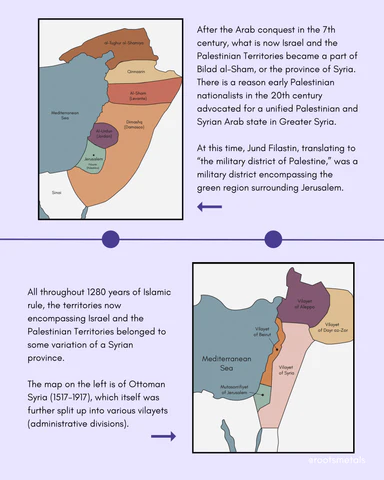
After the Arab conquest in the 7th century, what is now Israel and the Palestinian Territories became a part of Bilad al-Sham, or the province of Syria. There is a reason early Palestinian nationalists in the 20th century advocated for a unified Palestinian and Syrian Arab state in Greater Syria.
At this time, Jund Filastin, translating to “the military district of Palestine,” was a military district encompassing the green region surrounding Jerusalem.
All throughout 1280 years of Islamic rule, the territories now encompassing Israel and the Palestinian Territories belonged to some variation of a Syrian province.
The map on the left is of Ottoman Syria (1517-1917), which itself was further split up into various vilayets (administrative divisions).
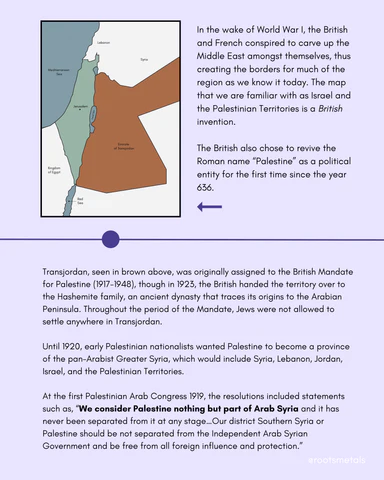
In the wake of World War I, the British and French conspired to carve up the Middle East amongst themselves, thus creating the borders for much of the region as we know it today. The map that we are familiar with as Israel and the Palestinian Territories is a British invention.
The British also chose to revive the Roman name “Palestine” as a political entity for the first time since the year 636.
Transjordan, seen in brown above, was originally assigned to the British Mandate for Palestine (1917-1948), though in 1923, the British handed the territory over to the Hashemite family, an ancient dynasty that traces its origins to the Arabian Peninsula. Throughout the period of the Mandate, Jews were not allowed to settle anywhere in Transjordan.
Until 1920, early Palestinian nationalists wanted Palestine to become a province of the pan-Arabist Greater Syria, which would include Syria, Lebanon, Jordan, Israel, and the Palestinian Territories.
At the first Palestinian Arab Congress 1919, the resolutions included statements such as, “We consider Palestine nothing but part of Arab Syria and it has never been separated from it at any stage…Our district Southern Syria or Palestine should be not separated from the Independent Arab Syrian Government and be free from all foreign influence and protection.”
ORIGINS OF ISRAEL
The earliest known mention of “Israel” in history — and the earliest mention of Israel outside of the Torah — is 3200 years old and was discovered in Thebes, Egypt, in 1896.
The mention is found in what is known as the Merneptah Stele, an inscription by the ancient Egyptian pharaoh Merneptah, who reigned between 1213 BCE to 1203 BCE. The Stele itself is dated to 1208 BCE. It’s written in ancient Egyptian hieroglyphs.
The Merneptah Stele mainly describes Merneptah’s victory over the ancient Libyans. However, three of the 28 lines talk about a separate Egyptian military campaign in Canaan. It reads:
“The Canaan has been plundered into every sort of woe:
Ashkelon has been overcome;
Gezer has been captured;
Yano’am is made non-existent.
Israel is laid waste and his seed is not;
Hurru is become a widow because of Egypt.”
The hieroglyphs used describe Ashkelon, Gezer, and Yano’am as city-states, whereas “Israel” is described as a foreign (to Egypt) people. This suggests that at this point in time, the Israelites did not rule over a unified state, but rather, were a nomadic or semi-nomadic tribe(s). This would corroborate the narrative of the Torah, as the Kingdom of Israel did not become a unified state until some 161 years later.
As a side note, it’s interesting that the first ever mention of Israel in history comes from a ruler bragging about our supposed destruction. Over three millennia later, here we are.
In 1040 BCE, a loose confederation of Hebrew tribes united to form the first centralized state in the Land of Israel, known as the Kingdom of Israel.
The Hebrew tribes originated -- and later split away -- from the Canaanites, a loose group of semi-nomadic tribes that lived during the second millenium BCE; they were the original inhabitants of the Land of Israel. Though depicted as the enemies of the Israelites in the Torah, archeologists, linguists, Biblical historians, and geneticists today widely agree that the ancient Hebrews were originally Canaanites themselves. The Tanakh itself even makes some vague references to the Hebrews’ Canaanite origins. Ezekiel 16:3 tells us, “Thus said the sovereign God to Jerusalem: by origin and birth you are from the land of the Canaanites — your father was an Amorite and your mother a Hittite.” The Amorites were a Canaanite people.
It was customary at the time and in the region for nations to name themselves after their most important deities. For example, Israel’s neighboring Assyria named itself after the Mesopotamian deity “Ashur.” “El” was the most important god in the Canaanite pantheon; over time, the cult of El and of the southern deity YHWH merged to form the Hebrew God as we know Him today. “Israel,” then, translates to “one who wrestles with El [that is, God].”
Until 1948, the United Kingdom of Israel (1047-930 BCE), the southern Kingdom of Israel (930-722 BCE), and the Kingdom of Judah (930-587 BCE) were the only ever sovereign nation states in the entirety of the land’s history. At all other times, the region was a colony, vassal state, or province of some foreign empire whose administrative center was elsewhere. The founding of the State of Israel in 1948 marked the first time that the land belonged to a fully sovereign, independent state in over 2500 years.
ORIGINS OF PALESTINE
Historians have long debated the origins of the name “Palestine.” Most believe that the word derives from the Hebrew and Ancient Egyptian word “peleshet,” translating to “invader” or “migratory.” “Peleshet” was used to describe the Philistines, who settled on the Mediterranean coastline above Egypt, in parts of what is now Israel and Gaza. The Philistines were a seafaring people of Greek origin, entirely unrelated to today’s Palestinians, who are an Arab ethnonational group. Some Palestinians, particularly Christian Palestinians and Palestinians from the city of Nablus, have Jewish and Samaritan ancestry, respectively.
The first use of the word “Palestine” to describe a geographic region was in the 5th century BCE, at least 700 years after the first use of the word “Israel.” Like the Land of Israel, “Palestine” was a loose region, describing the coastal strip that runs from Egypt to Lebanon. However, unlike “Israel,” Palestine was not a political entity until the Romans renamed Judea “Syria-Palestina” in the second century CE.
Another, newer, more controversial theory asserts that “Palestine” derives from the Greek word “Palaistes,” meaning “wrestler.” If you recall, the term “Israel” means “one who wrestles with God.” According to this theory, “Palestine” is a direct Greek translation of “Israel.”
For hundreds of years, the term “Palestinian” was virtually synonymous with “Jew.” In the 18th century, for example, Immanuel Kant described the Jews in Europe as “the Palestinians among us.” In the early 20th century, Jews used “free Palestine” as a rallying call to establish a Jewish state.
The first Arab Palestinian to identify as Palestinian was Khalil Beidas in 1898, though the term was not universally used until the 1960s. During the 1937 Peel Commission, Palestinian Arab nationalist Anwi Abd al-Hadi told the British, “Palestine is a term the Zionists invented!”
WHY IS THE STATE OF ISRAEL "ISRAEL"?
Though the second Kingdom of Israel was conquered by the Assyrians in 722 BCE, both Jews and Samaritans continued referencing to the land as “Eretz Israel,” or the Land of Israel, for three millennia. When the Maccabees briefly gained a semblance of independence after the Maccabean Revolt (167-141 BCE), they referred to their new semi-autonomous kingdom as “Judea” and “Israel” interchangeably. During the Bar Kokhba Revolt against the Roman Empire (132-135 CE), the revolt leader, Simon Bar Kokhba, was known as the “prince of Israel.”
Even during the British Mandate (1917-1948), the official name of Palestine was the “British Mandate of Palestine (Aleph Yud).” Aleph Yud are the letters corresponding to the abbreviation for “Eretz Israel,” the Land of Israel.
Even so, most assumed that the new Jewish state would be called “Judea,” or “Yehuda” in Hebrew. In 1949, on the first anniversary of the State of Israel, Zeev Sharef, who had been present during the deliberations, explained why the name “Judea” was quickly discarded: “Most people had thought that the state would be called Judea. But Judea is the historical name of the area around Jerusalem, which at that time seemed the area least likely to become part of the state...So Judea was ruled out.”
The Provisional Government of the State of Israel also spent some time deliberating on what the name for the country would be in Arabic. Initially they considered Palestine, or "Filastin" in Arabic, to "take the feelings of the Arab minority into account." But the idea seemed too confusing, because they assumed an Arab state would be established alongside the Jewish state, and that Arab state would likely be called Palestine. As such, the idea was discarded. Instead, Israel is called "Isra'il" in Arabic.
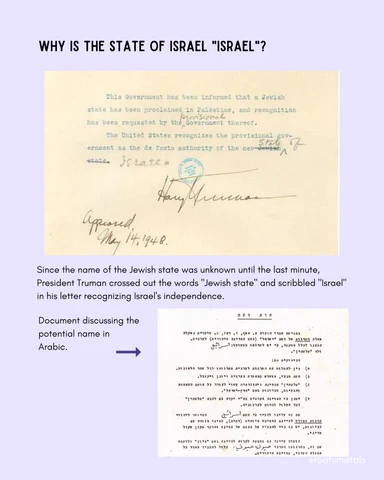
Since a lot of you guys seem to have a problem with reading comprehension, let me comprehend this for you: the point of this post is *not* to say only Jews have a right to live in the land, or to say that I unequivocally support everything the Israeli government has done, is doing, & will continue to do forever into eternity.
the point is: (1) the idea that Israel is “colonial” is ahistorical & antisemitic because it is a blatant erasure of Jewish history & identity, (2) the idea that Palestine is “anti-colonial” is also ahistorical and also an erasure of Jewish history, & (3) the “river and the sea” that you’re so damn attached to in the name of “anti-imperialism”?Yeahhhh those borders were a British invention.
For a full bibliography of my sources, please head over to my Instagram and Patreon.
26 notes
·
View notes
Text

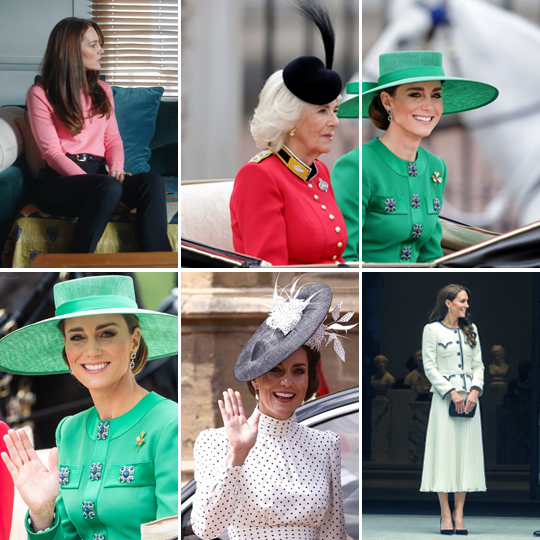

The Princess of Wales’ Year in Review: June
June 1st - The Prince and Princess of Wales were present at the Marriage of The Crown Prince of the Hashemite Kingdom of Jordan with Miss Rajwa Al Saif which took place at the Zahran Palace. They then attended the wedding reception
June 6th - The Princess of Wales visited Windsor Family Hub. That afternoon, she received Mrs. Alice Webb (Trustee of The Royal Foundation) at Windsor Castle
June 7th - The Princess of Wales, Joint Patron of the Royal Foundation and Patron of the Rugby Football Union, visited Maidenhead Rugby Football Club
June 8th - The Princess of Wales, Joint Patron of the Royal Foundation, held an Early Years Meeting
June 14th - The Princess of Wales, Joint Patron of the Royal Foundation, held an Early Years Meeting
June 15th - The Princess of Wales, Joint Patron of the Royal Foundation of The Prince and Princess of Wales, visited Riversley Park Children's Centre. Later, she received Professor Eamon McCrory (Board Member of the Royal Foundation Centre for Early Childhood Advisory Group) at Windsor Castle
June 16th - A film was released highlighting the vital role that health visitors play in the community, which includes footage of The Princess of Wales shadowing health visiting teams at Homerton Healthcare NHS Foundation Trust. That evening, the Prince of Wales, Colonel of the Welsh Guards, and The Princess of Wales, Colonel of the Irish Guards, attended the Senior Colonels' Conference and Dinner at Clarence House
June 17th - The Wales family joined the extended members of the British Royal Family at The King's Birthday Parade, also known as Trooping the Colour
June 19th - The Princess of Wales was present when the King, accompanied by The Queen, The Prince of Wales, and others, held a Chapter of the Most Noble Order of the Garter in the Throne Room, Windsor Castle. The King later gave a Luncheon Party for the Companions of the Most Noble Order of the Garter at which The Queen, The Prince and Princess of Wales, and others were present
June 20th - The Princess of Wales, Patron of the National Portrait Gallery, officially reopened the newly renovated National Portrait Gallery
June 22nd - Prince George was spotted touring Eton alongside his parents
June 23rd - The Prince and Princess of Wales honoured Royal Ascot with their presence
June 24th - The Princess of Wales joined Roger Federer in a video for Wimbledon, focusing on the ball boys and girls
June 27th - The Princess of Wales officially opened Hope Street
June 28th - The Princess of Wales, Patron of the Victoria and Albert Museum, officially reopened the newly renovated Young Victoria and Albert Museum
June 29th - The Princess of Wales, Joint Patron of the Royal Foundation, held an Early Years Meeting. Afterwards, she held further meetings. The Country Life cover photographed by the then-Duchess of Cambridge won the Cover of the Year title at the PPA Awards, the ‘Oscars’ of the magazine world
June 30th - The Princess of Wales, Joint Patron of the Royal Foundation, received Professor Eamon McCrory (Board Member of the Royal Foundation Centre for Early Childhood Advisory Group) at Windsor Castle
#mine#royaltyedit#kate#yearreview#hussein and rajwa#windsor family hub 23#alice webb 23 2#maidenhead23#ey meeting 23 9#ey meeting 23 10#nuneaton23#eamon mccrory 23 3#colonel conference 23#trooping the colour 2023#garter 23#npg23#ascot23#ball boys and girls 23#hope street#vanda23#ey meeting 23 11#meeting23 2#eamon mccrory 23 4
44 notes
·
View notes
Text
Jewish History and Zionism.
Or: why you gotta be so difficult about that tiny piece of land?
Ft. Britain, Ottoman empire, the Age of Enlightenment, and helll lot of racism.
(But like. That was obvious.)
ToC:
Britain, shortly (or: the problem with "but they created Israel!!")
Indigenous
Jews in the 19th century
The ottoman empire (pt.1 - geography and maps)
Bibliography (cited articles)
Edit: I changed/removed things that were spesificly for the person I had this discussion with, as they show understanding of what was problematic with their og comment, and regrets it.
~
A. This was not about you personally. It was about the way Jewish pain is constantly generalized and turn into something for "the world". Somehow, Jewish tragedies are either ignored or "a lesson for the world".
B. My problem with the term was that by saying "as a FELLOW JEW" you claim relationship to the community and kinship which you later use to dismiss cultural and community issues. You are Jewish (as your mother). My issue is that the only usage you seem to have is to make claims. This is... disturbing, seeing claimed made while ignoring the historical background. (AKA 2,000 years of exile, enslavement, oppressions and murders).
~
1. Britain:
The British were involved in the creation of The Jewish State, Israel by the “Balfour Declaration”. The League of Nations is a predecessor to the United Nations.
Yes, the British were involved in the creation of the Jewish state. As well as the Emirate of Trans-Jordan (1921-1946) - later became "Hashemite Kingdom of Jordan" (est. 1946). Also in the creation of India, Pakistan, and many other countries no one seem to have an issue with.
Also the france were involved in the creation of Lebanon, Algeria, Lybia, etc.
(The world was mostly controlled by EMPIRES. So yes. When an empire fall apart, sometimes there is an involvement in what happens next.)
Focusing on a certain group and judging them and their actions by different standards then others is. Uh. Pretty racist view, you know?
Britanica:
Alarmed by the extent of Arab opposition, the British government issued a White Paper in June 1922 declaring that Great Britain did “not contemplate that Palestine as a whole should be converted into a Jewish National Home, but that such a Home should be founded in Palestine.” Immigration would not exceed the economic absorptive capacity of the country, and steps would be taken to set up a legislative council. These proposals were rejected by the Arabs, both because they constituted a large majority of the total mandate population and therefore wished to dominate the instruments of government and rapidly gain independence and because, they argued, the proposals allowed Jewish immigration, which had a political objective, to be regulated by an economic criterion.
This is the area of the "British Mandate of Palestine". Brits had separated it and gave 2/3 and claimed it a different reign.
As for governing - The Hashemite emir Abdullah, elder son of Britain's wartime Arab ally Hussein bin Ali, was placed on the throne of Transjordan.
Yet, for some reason, no one ever said anything like "from the river to Iraq, all the land will be back."

Hi, guess what is it called when there are laws that forbid and heavily reduce members of a spesific group from living in certain areas?
(Strangely, no such boundary was set on the immigration of Muslims, Christians, or any other kind of people. Only jews.)
Source: Israel embassy
In 1920, the Council of the League of Nations appointed Britain as the Mandatory entrusted with the administration of the Land of Israel. The borders of the land, as a separate country, were defined for the first time in many centuries. Until then, under the Ottoman Empire, the land's boundaries had not been defined because it was part of other large Ottoman districts like the district of Damascus and was not a distinct political unit. The term name "Palestine" that was chosen for this Mandate was based on the term name "Palestina" that was given to the country by the Roman Empire in the second century CE.
The territory of the British Mandate included land on both sides of the Jordan River, encompassing the present-day countries of Israel and Jordan. About 77% of this Mandate was east of the river Jordan River, and in 1921, Great Britain created there a separate administrative entity called Transjordan. The changed mandate took effect in 1923
2. Indigenous
Here's another part I want to dig in deeper:
"(the arabs) constituted a large majority of the total mandate population" -
The Arabs. Notice the name? I wonder how they got there. A true mystery. Green: Arab Peninsula. Red: area in question.

Hebrew was spoken in the area long before Muhammad and the Muslim empire.
I grew up near a 2,000 year old burial cave. The stories I learnt about my heritage happened in places I knew, with names I understood the meaning of.
This is the equivalent of calling for land back in Pennsylvania in the name of Pennsylvania Dutch.
3. Jews in the 19th century
Part of the reason for low Jewish population in the area was that unlike any other people, Jews were legally prohibited from living in the area. Now, some background: in general, the Ottoman empire was a pretty descent place for Jews, comparing to other places. Sure, had to pay extra taxes and not allowed to live in places, but you can mostly know you won't be exiled once the authorities felt like (looking at you Britain, Yemen, Spain, Morocco, and more). The 19th century had marked a rise in nationalism (results to the Fall of Empires in the 20th century). It also saw the coin of a new term: "antisemism".
This came to describe Jew-hatred that isn't focused on the religious part ("they killed Jesus"/"They kept faith for themselves"), but seem to have a more "neutral" reason. Even scientific, as "they are naturally inferior" (see "the race theory", Eugenics, and more.) If you see similarities with Romanis in Europe and Black people in America - yes. This wasn't just about Jews - it was a general trend due to the so called "Age of Enlightenment" in Europe.
Part of the things that happened to/in the Jewish Community in the 19th century including:
1860: Foundation of "Alliance Israélite Universelle" an international Jewish (charity) organization.
First mass Aliya (immigration to Israel) of Yemeni jews in 1882/Jewish year of תרמ"ב (aka "אעלה בתמר")
1827 (Russia): the "cantonists' Decree"
The "okaz" (regulation, instruction) of the emperor from the end of August 1827, which imposed an obligation on the communities to provide the monarchy with a fixed quota of rookie soldiers, stunned the Jewish population. The terrible tragedy of the kidnapping of Israeli children (from the age of twelve according to the law, but actually even from the age of eight) for military training is known in the history of Russian Jews, and has even been commemorated in literature. The service in the Nikolai army, which lasted twenty-five years, was counted from the age of eighteen, and the years of "education" of the minor abductees, the "cantonists", were not included in it, as these years were out of the calculation. The purpose of the government in this decree was to convert the Jews to their religion and to mix them with the Pravoslav Christian Russian population.
(translated from: Maor, Y., 1981)
1881-2: Sufot Banegev - mass Pogroms of jews in south-east Russia (Ukraine, Poland) after Tzar Nikolai's murder. The Jews were accused of the murder. I was unable to find any information in English, but here's one in Hebrew ("today in history"). (I might be able to get one in Russian if you know that.)
May Laws (link to online version of the Jewish Encyclopedia.)
During the 1880s - founding of multiple "Lovers of Zion" organisations in Russia.
The assassination of Tsar Alexander II in
1881 ushered in a painful new era. The pogroms after his death were followed by the notorious 'May Laws' of 1882 which stepped up economic discrimination against the Jews. The stirring among the Jewish community, both physical and intellectual, was heightened. Many more of them started to leave, mainly for America, and not a few began to think seriously about Jewish nationalism, with the result that the 'Lovers of Zion' Movement gained momentum. Some of them, whether for reasons of sheer physical safety or nationalism or a combination of both, thought of finding a home in the Ottoman Empire. (Mandel, 1974)
1894 (France): The Dreyfus affair
Theodore Herzl, a Jewish Journalist, was there as a reporter. He said this was the moment he realised jews As a journalist in France, Herzl became extremely upset during the Dreyfus affair, in which a Jewish army officer was falsely accused and convicted of espionage. The only solution to the problem of the Jews, he decided, was to create a Jewish state. Although Dreyfus was ultimately pardoned (in 1906), the episode revealed that emancipation would be an incomplete and ongoing process.
1896 (Vienna): Theodore Herzl published his book "Der Judenstaat: Versuch einer modernen Lösung der Judenfrage" (The Jews’ State: An Attempt at a Modern Solution to the Jewish Question)
Herzl published this work, Der Judenstaat, to galvanize his fellow Jews into action. He asserts that emancipation itself caused antisemitism, since it failed as a movement. He concludes that Jews cannot continue to live among other nations since their presence inevitably gives rise to hostility. Herzl’s answer was for Jews to organize a mass migration to a territory of their own.
1897: the First Zionist Congress of the Zionist Organization. The official goal of Zionism (Basel Program) read: "Zionism seeks to establish a home in Palestine for the Jewish people, secured under public law."
As we can see, the 19 century wasn't good to jews, especially in Russia (and I mean Russia of that time - which included the area of Ukraine, and parts of Poland). Starting with a legal forced children-kidnapping. During the 80s, massive pogroms, on long time and area, had spread terror among the Jewish communities. The authorities' refusal to assist and victim blaming weren't uncommon, but not in those masses. 2.4 million jews had left Russia during those years, mostly to the USA, Canada, and Argentina (115.000 ppl). 3% (~73,000 ppl) had immigrated to Israel.
Also a worldwide rise in nationalism*, that was also used as a reason for jew-hatred (bc what bring ppl together better than having the same enemy?). In France, the Dreyfus affair made Herzl realise that the emancipation (jewish semi-autonomous areas, a-la Reservations in usa) wouldn't work. It won't help to prevent the systematic and cultural discrimination. Eventually inventing *modern day* Zionism - secular consept. (not to be confused with Hibat Ztiyon/"Zion Loving" - which was an old Jewish consept since the first exile, 6th century BCE.
*Nationalism, as itself, wasn't a bad thing. It was a big part of decolonisation (as different groups in the empire demanded to have their own autonomy.)
4. Ottoman empire (Geography and MAPS)
Let's skip a few thousand miles away, to the Ottoman empire.
First thing we need to know is - how the map looked like, back then?
The empire was divided into different areas, that all had sub-areas, et al. For better understanding, think about it like USA's country vs. state. Vs. reign.
The empire was divided into different EYALETS (aka beylerbeyiliks. after 1860s- Vilayet), that contained several Sanjcks, that contained several Kazas.
This is a map of the empire in 1875, as it already started to fade:

Two more maps for better understanding of spesific areas
The Damascus Eyalet in 1795 (red):
(the north-west (top-left) is Sidon/Beirut/Sefad Eyalet. Do you see the Sea of the Galilee? It's the little dot in the middle).

1896:

Authority areas kept changing. This is another map, showing Vilayets (Syria, Beirut, Aleppo) and their Sanjaks (+independent Sanjak of Jerusalem).
I'm pretty sure that this one is the simplified version:

Why do I show it?
Well, first of all - definitions. Making sure we all know what area we're talking about. During the years, "Filistin"/"Palestine"/"Paleshet" used to refer to many areas: from almost all the southern levant to a coast reign, about the size of modern-day Gaza Strip.
Secondly? Our next part, about the Jews and the empire. Especially the 1881 declaration by the Council of Ministers that
"[Jewish] immigrants [would] be able to settle as scattered groups throughout Turkey, excluding Palestine".
(Mandel, 1974)
I wonder why..
~
I've been working on it for days, so I'll post this now and add the second part, in which I'll explain this last bit and continue, later.
Next part: immigration, Zionism, and the breaking point in the Jewish-Arab relationship (no, not 1948. It was 1929.)
Bibliography:
Mandel, Neville J. ( 1974). "Ottoman Policy and Restrictions on Jewish Settlement in Palestine: 1881-1908: Part I" (PDF). Middle Eastern Studies. 10 (3). Taylor & Francis, Ltd.: 312–332. Retrieved 29 March 2024.
Maor, Y. (1981). The “Sufot Banegev” as a Factor in the Rise of Nationalism among the Jewish Intelligentsia / ה"סופות בנגב" כגורם להתעוררות התודעה הלאומית בקרב המשכילים היהודיים. Proceedings of the World Congress of Jewish Studies / דברי הקונגרס העולמי למדעי היהדות, ח, 1–12. http://www.jstor.org/stable/23526296)
#history lesson#history#maps#seriously I put so much research on it#ottoman empire#britain#mandate#Palestine#israel#russia#19th century#jewish history#jumblr#nerding out#sufot Banegev#Zionism#well the beggining of#pogroms#mass murder#ukraine#poland#long bloody history#damn it#tbc
7 notes
·
View notes
Photo

Bowl. ca. 3500–3300 BCE. Credit line: Courtesy of the Department of Antiquities of the Hashemite Kingdom of Jordan, Purchase, Rogers Fund, 1978 https://www.metmuseum.org/art/collection/search/326504
#aesthetic#art#abstract art#art museum#art history#The Metropolitan Museum of Art#museum#museum photography#museum aesthetic#dark academia
12 notes
·
View notes
Text
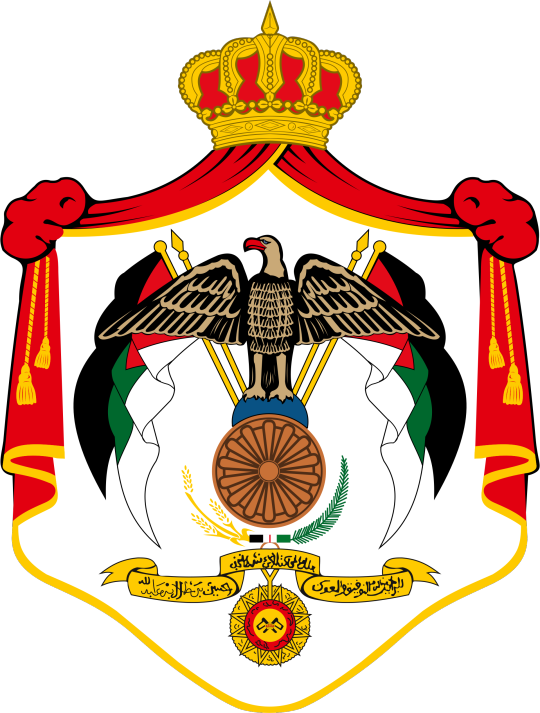
Coat of Arms of the Hashemite Kingdom of Jordan during the reign of King Hussein. Inscription on the scroll comprises three phrases. On the right side: “Al Hussein bin Talal bin Aoun” (Aoun is the great grandfather of Al Sharif Al Hussein bin Ali). In the middle: “King of the Hashemite Kingdom of Jordan.” On the left side: “Who seeks support and guidance from God.” (Wikipedia)
10 notes
·
View notes
Text
GERMANY: STOP BEING NAZIS!
A group of autonomous actors targeted the German Consulate in New York City in the early hours of the morning on Wednesday, June 12. Actionists splashed blood-red paint on the exterior of the consulate and wheatpasted an official-looking apology from the German government for their active participation in the Zionist entity's genocidal assault on Gaza.
The German state supplies 30% of the IOF's weapons and is the second-largest supporter of the Zionist entity, behind only the U.S. In 2023, Germany approved $320 million in military aid to the entity — over ten times more than in 2022. Germany's generous funding has made this genocide possible. Meanwhile, German leaders have criminalized the Palestine solidarity movement, making mass arrests and cynically banning protests in the name of so-called antisemitism. In solidarity with pro-Palestinian movements in Germany, the actionists demand that Germany recognize the Palestinian State and support the recognition of an independent Palestinian state in the EU.
This action is part of a broader international escalation—undertaken in response to calls from Gaza—to hold accountable all entities that aid and abet the ongoing colonization of the Palestinian people. The Zionist entity relies on a network of puppet states, normalizers, and imperialist allies to maintain its brutal status quo. Other actions in New York City today targeted the U.S. Campaign on Palestinian Affairs, the Permanent Mission of the Hashemite Kingdom of Jordan to the United Nations, and the Consulate General of Israel.
In a communiqué issued this morning, the New York City actionists write:
"Through our actions we continue to globalize the intifada. We locate complicity in the genocidal campaign against Palestinians among all nations who refuse to cut ties with the Zionist settler state, refuse to support Palestinian freedom and the right to return, and profit from the attempted annihilation of Palestinian people. We as dissidents in the imperial core urge comrades everywhere to consider all normalizers our enemies and join in creative resistance to every state actor and institution that aids and abets genocide."
Reshare on Pal Action Instagram: https://www.instagram.com/reel/C8H6vviu9hg/
#germany#europe#videos#video#class war#nazisploitation#nazis#nazigate#nazi#neonazis#neofascism#ausgov#politas#auspol#tasgov#taspol#australia#fuck neoliberals#neoliberal capitalism#anthony albanese#albanese government#fortress europe#fascism#russian imperialism#anti imperialism#american imperialism#us imperialism#fuck imperialism#antinazi#antifascist
5 notes
·
View notes